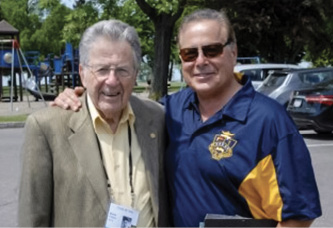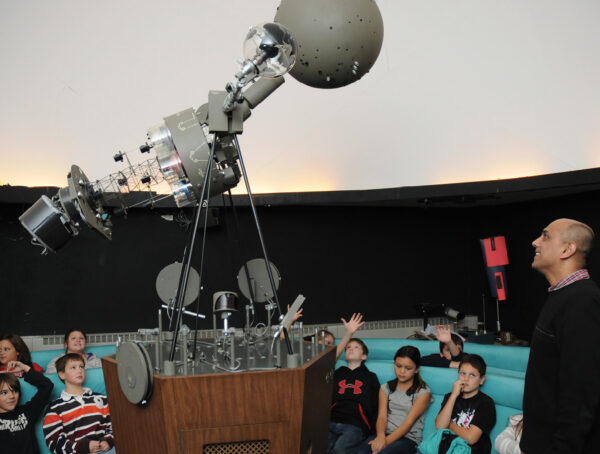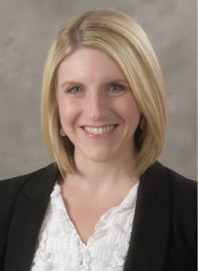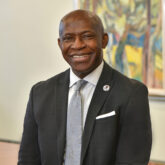If the statue of Edward Austin Sheldon could suddenly come to life, the picture-perfect day of September 30, 2005, may have been a good time. If the joy of the day somehow brought the college’s founder back and he took a stroll from his chair, many details would have astounded him. The buildings, and the whole scope of the campus, would have far exceeded the place he knew.

More than 1,500 students, alumni, faculty and staff turned out for the “Oswego Family Portrait” to launch Inspiring Horizons: The Campaign for Oswego Sept. 30, 2005.
The first building he would see, the one in front of which his statue sits, would bear his name. Sheldon Hall also represents the oldest and first building on the college’s current site. The architecture would likely be the most familiar to him, even if the cornerstone was laid in 1911, or 13 years after his death. The hallways themselves would look like the insides of a school he knew, and he may have felt at home in the historic classroom.
Peering inside one of the modern classrooms or offices, however, would prove more startling. Computers, large-screen video boards, all manners of electronic devices would look unfamiliar, though he likely would approve of the benefits they provided to learning.
But since it was a nice day and the sun was shining on his face, let us assume Sheldon instead favored an outdoor stroll to the lakeshore. Walking several strides west would find him meeting an avenue that bears his name. If he took that left, the first thing he would see on his right is the Mackin Complex. This building houses two residence halls, Lonis and Moreland, as well as a full-service dining hall. Home to traditional features of the residential campus, the building houses around 140 students, many of them upperclassmen or graduate students. The magnitude of today’s residential campus with more than 4,300 students living on it may prove a slightly startling development compared to when most students lived off campus when his normal school was downtown.
On his left, he would find Rich Hall, home to the college’s School of Business. Over the years, it also served as the first campus library building and later home of University Police — could he imagine his little normal school having its own police force? The architectural stylings, part of a renovation more than a century after he passed, may have seemed a tad unusual.
He may be surprised that his teacher training institute now included this School of Business in addition to a School of Education, plus a College of Liberal Arts and Sciences and School of Communication, Media and the Arts. The international nature of business, and how people in this building could close deals with a keystroke via the Internet, would perhaps prove mind-boggling. But as a longtime champion of having the most modern and helpful equipment, he would approve of its state-of-the-art nature. And that students learn by doing — the hallmark of the object learning method he helped popularize — would please him greatly.
If he continued to follow Sheldon Avenue toward the lake, he would see a familiar sight: His onetime home, Shady Shore. Today, Shady Shore is the home of the college’s tenth president, Deborah F. Stanley. While the thought of a woman president may have seemed far away for many 19th-century residents, we doubt Sheldon would be too surprised. Many female administrators were key to the college’s foundation, and he made no secret their value to the institution.
But Sheldon’s nostalgia over his homestead would likely be superseded by the sound of hundreds of voices further around the bend on Rudolph Road. There he would see well over 1,000 people, most dressed in yellow T-shirts.
The idea of a $17 million college campaign having its public launch that day may well seem hard to fathom in scope — as could the $23.8 million the campaign would raise before its conclusion. The first building purchased for the campus cost a mere $31,000. The college’s initial state annual funding of $2,128.50 was a lot of money in the 1860s.
But despite all the differences, there would be plenty in the scene the founder would have recognized. The easy camaraderie, the laughing, the grins among the people assembled would have been familiar. The marvelous backdrop, the splendid vista of Lake Ontario, would have looked the same. And maybe, just maybe, he would catch a certain spirit in the air, an affable joie de vivre, that he expected to feel among the community.
One can’t help but imagine Sheldon smiling at the whole scene. How far, yet fruitful, the journey to this place from a dream he had in the middle of the 19th century.
Tim Nekritz M ’05 is SUNY Oswego’s associate director of public affairs/director of web communication. This is an excerpt from his unpublished history of the college, reprinted here with his permission.
More from Class Notes
Class Notes – Winter 2024
Class Notes - Winter 2024 Editor’s Note: Due to changes to our typical production schedule, this Class Notes reflects submissions from July …
From the Archives – Winter 2024
From the Archives - Winter 2024 SAVE THE DATE: April 8, 2024 Oswego will experience a very rare total eclipse of the …
Oswego Matters – Winter 2024
Oswego Matters - Winter 2024 As a mother of two young children, I’ve grown accustomed to frequent transitions; to new beginnings; …











